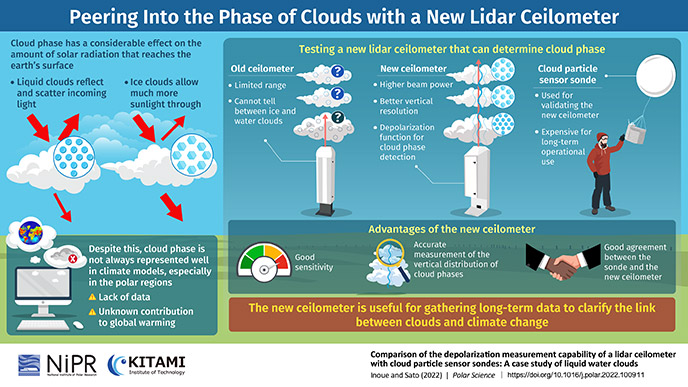National Institute of Polar Research
Testing Out a New Ceilometer that Can Distinguish Between Ice and Liquid Clouds
A tool that could help scientists integrate the phase of clouds into climate models, leading to a better understanding of global warming
November 17, 2022
Cloud phase is an important factor that determines how much solar radiation reaches the earth’s surface, but it is not well represented in polar regions in climate models owing to a lack of data. In a recent study, Japanese researchers tested out the capabilities of a new ceilometer that can accurately distinguish between liquid and ice clouds, paving the way for the adoption of this tool in future climate studies.

The more we learn about climate systems, the more we realize that we are barely scratching the surface. Recent studies have revealed intricate links between seemingly unrelated phenomena, such as how changes in ocean winds and wave height can increase the organic matter that changes cloud properties and alter their optical properties. Unfortunately, our understanding of climate systems in the polar regions, which are the most vulnerable to global warming, are rather limited owing to a general lack of data.
In general, climate models can poorly represent the effects of the phase of clouds, particularly in polar regions. Liquid clouds, which are composed mostly of suspended water droplets, scatter and reflect much more solar radiation than ice clouds, in which the liquid droplets have merged and solidified into larger ice particles. However, accurately measuring the phase of multiple cloud layers is challenging and costly, and climatologists are somewhat in the dark as to how much global warming affects cloud phase and vice-versa in polar regions.
To address this problem, a pair of Japanese researchers from the National Institute of Polar Research and Kitami Institute of Technology have been trying out a new tool for conducting measurements of cloud phase in a convenient way. As explained in their latest paper published in Polar Science, the researchers sought to test the ability of a new lidar ceilometer called the Vaisala CL61 to gather much-needed data on clouds in polar regions.
So what is a lidar ceilometer and why is this new model more useful than previous ones? A lidar ceilometer is a portable instrument that shoots a laser beam up into the sky and captures the portion of the laser reflected back down by the clouds. While they are typically used to determine how high the cloud base is, the new ceilometer tested in this study offers an additional functionality. Thanks to its higher beam power and a built-in depolarization function, the CL61 ceilometer can be used to distinguish between solid and liquid particles, which in turn provides information about cloud phase.
Motivated by these new capabilities, the researchers carried out measurements with the new ceilometer in northern Japan and compared them with measurements taken using a cloud particle sensor (CPS) sonde. The CPS sonde is a balloon-launched device that can very accurately determine cloud phase it passes through as it rises. Compared to a ceilometer, however, CPS sonde measurements are more time-consuming and expensive for long-term operational use. The researchers also compared the measurements of the new ceilometer with those of an older model without the depolarization function.
Overall, the new ceilometer was able to accurately measure the vertical distribution of cloud phases across multiple cloud layers with good sensitivity to cloud water content. Associate Professor Jun Inoue of the National Institute of Polar Research, lead author of the study, remarks on the importance of this comparative analysis on the latest cloud observation equipment. “The long-term data acquisition by this new ceilometer will be crucial for understanding the relationship between changes in clouds and climate,” he states, “Making visible the response of cloud phase to rapid changes in climate systems will hopefully make people think more about how to act under the current global warming scenario.”
Besides climate science, the new features of this new ceilometer could be useful in other practical applications in the short-term. “This new ceilometer could be used to estimate the probability of icing on aircrafts in supercooled liquid clouds,” explains Associate Professor Inoue, “Additionally, it could also be used to measure aerosols. By detecting the sphericity and relative amount of aerosol particles, their type can be inferred, which could be helpful to identify threats to human health in urban areas.”
In any case, this study made it clear that there is much untapped potential in the novel capabilities of modern ceilometers. With any luck, their increased use in polar climate science will let us prepare better for the consequences of global warming.
Original article:
Journal: Polar Science
Title: Comparison of the depolarization measurement capability of a lidar ceilometer with cloud particle sensor sondes: A case study of liquid water clouds
Authors:
Jun Inoue (National Institute of Polar Research, Japan)
Kazutoshi Sato (Kitami Institute of Techology, Japan)
DOI: 10.1016/j.polar.2022.100911
URL: https://www.sciencedirect.com/science/article/pii/S1873965222001979
Published: November 5, 2022
Funder:
The Arctic Challenge for Sustainability II project, Japan (grant number: JPMXD1420318865) supported this research.








